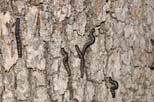Athens, Ga. – Researchers at the University of Georgia are tracking an outbreak of caterpillars that can eat and strip the leaves off oak trees, potentially affecting the tree’s health for a year or more. The leaf-eating caterpillars have been confirmed in several counties surrounding Athens, including Clarke, Madison, Oglethorpe and Oconee. They are also possibly in both Barrow and Gwinnett counties, but UGA researchers fear they are also spreading throughout the state.
Kamal Gandhi, an assistant professor of forest entomology in the UGA Warnell School of Forestry and Natural Resources, said home- and landowners began bringing her caterpillars last year for help with identifying the insects. The grayish-brown caterpillars had black heads and thin white lines down each side and were moving into the oak canopies at night to feed on leaves and seemed to favor white oaks. And they weren’t in the book on moths in North America that Gandhi could find, so she sent them to moth expert David Wagner with the University of Connecticut for help identifying them using DNA coding. That’s when they found that Georgia is now experiencing what appears to be an outbreak of the Black-dotted Brown moth (Cissusa spadix) that until now weren’t considered pests. They even found that this caterpillar defoliated a large white oak tree growing in Athens’ Whitehall Forest in just four days last year. This year, Gandhi said its spring leaves were delayed, and the caterpillars have returned in higher numbers.
Gandhi and Jacqueline Mohan, an assistant professor of terrestrial ecosystem ecology in the Odum School of Ecology, speculate that the moths went into an outbreak phase because of much warmer weather conditions with abundant autumn rainfall in 2009 and 2010, which stimulated the development and growth of both oak trees and leaves, and caterpillars. Entomologists living in Athens for decades and across eastern North America have never witnessed an outbreak of this moth species before.
What should homeowners look for? Gandhi said the specific signs that those caterpillars have possibly made themselves at home include:
– Oak trees on a homeowner’s property that have been stripped of leaves;
– Dark grayish-brown caterpillars with thin white lines on both sides that feed on the leaves mostly at night;
– A yard covered in the small black insect frass (excrement); and
– Caterpillars that come into the house at night and vomit reddish-brownish liquid.
Very little is known about how to manage these insects, Gandhi said, but if a landowner does have an infestation, there is a simple way to help thwart their efforts to feed on oaks: Put burlap bands on high value trees to stop them from moving into the canopy. Burlap bands can be made by tying a piece of twine, rope or string around the tree and then slipping a foot-wide piece of burlap between the rope and tree, folding it in half over the string. The band should circle the entire tree, and the bottom part should be duct-taped to stop caterpillars from crawling under and through the bark cracks. The caterpillars should become caught in the burlap and can then be disposed of using soapy water after capture. Burlap bands are only partially effective, however, and Gandhi said it is unclear how effective pesticides are as well.
This insect is a bit of a mystery to scientists. They’re not even sure where the insects lay their eggs. What they do know is that the hatched caterpillars typically spend a day in leaf litter on the ground and under bark cracks and furrows, especially on white oaks. They then climb into the trees for feeding, pupating in early May in the litter layer until emerging as an adult the following year.
Gandhi and Mohan have launched both individual and collaborative research projects into the strange insect. Gandhi and her post-doctoral researcher, David Coyle, are working on determining what host plants the caterpillars prefer, its life-cycle, the extent and scale of defoliation this moth can inflict, and insecticide options to guide home-owners. Mohan and her students, Fern Lehman, Shafkat Khan and Paul Frankson, also are using the caterpillars to determine how herbivorous insects might respond to oaks grown in higher temperature conditions.
Based on the their 2010 research, they are finding that oak leaves grown under the higher temperature conditions predicted over this century lead to higher rates of caterpillar herbivory as the foliage becomes less nutritious and the insects need to consume more of it.
Gandhi and Mohan need to know how widespread the moth is in Georgia. Any calls and emails from homeowners from other counties will assist in research and management activities. Anyone with questions or information about this caterpillar can contact Gandhi at kgandhi@warnell.uga.edu.





